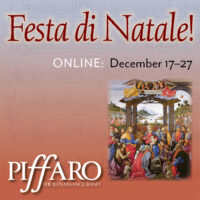As regards my professional activities, life has really been divided in two — the scholarly and the practical, you might say. It’s maybe not so different from the early-music field as a whole, although I wish it were not divided at all. I’ve been in school since I was five, and I’ve been doing music for about the same amount of time.
As a scholar, I study Medieval music. Really old Medieval music. A great sadness is that there is — or was — a huge amount of music that we can never hear, because it never occurred to anybody to write it down. People have always danced at weddings, sung lullabies to their children, crooned songs of love and sorrow, marched in rhythm. And yet we have no such music at all from Western culture until somebody thought to write it down.

But for almost all of the Middle Ages, the only people who were in a position to write things down were, obviously, people who knew how to write, and those were church people (cleric and clerk are the same word). So the great majority of notated music is music for the church, starting with books of words in the eighth century and books with notation in the ninth — music that we can sing! (It’s not until the 13th century that we begin to have notated music for secular songs, and not until the 14th that we have any sort of instrumental music.)
Most of that Medieval church music is what we now call Gregorian chant, and it is music for worship, for the continuous praise of God in the western Catholic tradition. It’s still in use today, and for me it’s very beautiful indeed. I like it for its musical qualities, but many others also love it for spiritual sustenance.
In my opinion, every senior voice recital in any music school or conservatory should have a Gregorian Alleluia, gradual, or tract. It’s some hard music, and very, very beautiful. Take a big breath and sing those melismas!
The other part of me is involved with playing early music. I directed early-music or historical performance programs at Wellesley College, the Five Colleges in Western Massachusetts, and Oberlin Conservatory; I ran a summer music festival in Massachusetts in the 1970s and 1980s; and I did my decades as a church organist and choir director. In that part of my activities, it was essentially Renaissance and Baroque music. Renaissance to start, long ago, since there were a lot of recorders and viols around, and there was beautiful ensemble music, some of which was not too hard to play.
More recently, though, I think that what so many people call “early music” is essentially centered on the Baroque, with various other repertoires (Renaissance, Classical, non-Western) sometimes visible in the penumbra.It seems to me that most of the HP instrumental ensembles today, at least in the U.S., are centered on Baroque music: trios, quartets, orchestras, performances of Baroque operas and oratorios. Some of the larger ones extend their repertoires into the Classical period, maybe even early Romantic. Occasionally one of them may extend backwards into (usually very late) Renaissance music or earlier — Gabrieli, earlier Monteverdi, Praetorius. And there is a whole second category of earlier-music ensembles, Medieval and Renaissance; these may be vocal ensembles or instrumental ensembles of winds or strings. Of these, a very few specialize in Medieval music; those that we recognize as being part of “our” world are usually focused on secular music, mostly the grand repertories of troubadours, trouvères, German Lied, Hispanic lyric. The exception to this secular orientation is the devotional music of Hildegard.
What does not usually enter into our HP world is the multitude of chant choirs, which regularly perform from the largest surviving repertoire of Western vocal music. A few of these are like HP ensembles in that they are professional, they record and tour, they hold themselves to high standards. Many others are devotional, performing mainly at religious services and festivals. And still others extend into the weird, the Gothic, the Creative Anachronisms… and that world seems to taper off into non-HP music-making.
In fact, of course, that sort of tapering off is true in many other repertoires as well, but it seems particularly significant here since most of these off-the-grid groups would not be likely members of EMA, which is open to a wide range of global “early musics” but mostly sticks to performance styles and attitudes that are, or try to be, historically informed.
So although I think of myself as both a scholar of chant and a practitioner of early music, I wish those two things could be one. Perhaps if we welcome into our circle those people slightly outside our usual definition, our circumference could be bigger.
Thomas Forrest Kelly is Morton B. Knafel Professor of Music at Harvard. He is past president and a longtime board member of Early Music America and the author, most recently, of Melisma: Wordless Song in Medieval Chant (Oxford Univ. Press).

